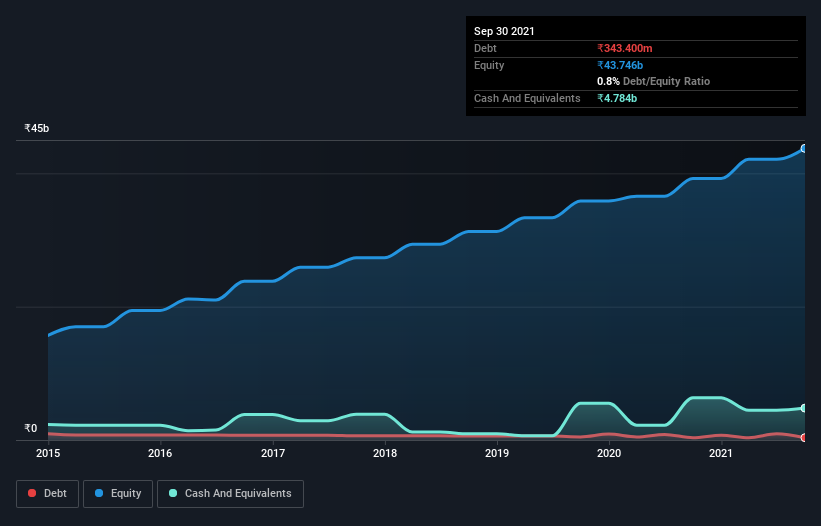
David Iben put it well when he said, 'Volatility is not a risk we care about. What we care about is avoiding the permanent loss of capital.' So it might be obvious that you need to consider debt, when you think about how risky any given stock is, because too much debt can sink a company. As with many other companies Amara Raja Batteries Limited (NSE:AMARAJABAT) makes use of debt. But should shareholders be worried about its use of debt?
Why Does Debt Bring Risk?
Debt assists a business until the business has trouble paying it off, either with new capital or with free cash flow. If things get really bad, the lenders can take control of the business. While that is not too common, we often do see indebted companies permanently diluting shareholders because lenders force them to raise capital at a distressed price. By replacing dilution, though, debt can be an extremely good tool for businesses that need capital to invest in growth at high rates of return. When we think about a company's use of debt, we first look at cash and debt together.
View our latest analysis for Amara Raja Batteries
How Much Debt Does Amara Raja Batteries Carry?
The chart below, which you can click on for greater detail, shows that Amara Raja Batteries had ₹343.4m in debt in September 2021; about the same as the year before. But on the other hand it also has ₹4.78b in cash, leading to a ₹4.44b net cash position.

How Healthy Is Amara Raja Batteries' Balance Sheet?
We can see from the most recent balance sheet that Amara Raja Batteries had liabilities of ₹14.8b falling due within a year, and liabilities of ₹2.72b due beyond that. Offsetting this, it had ₹4.78b in cash and ₹7.21b in receivables that were due within 12 months. So its liabilities total ₹5.51b more than the combination of its cash and short-term receivables.
Since publicly traded Amara Raja Batteries shares are worth a total of ₹105.6b, it seems unlikely that this level of liabilities would be a major threat. Having said that, it's clear that we should continue to monitor its balance sheet, lest it change for the worse. Despite its noteworthy liabilities, Amara Raja Batteries boasts net cash, so it's fair to say it does not have a heavy debt load!
Fortunately, Amara Raja Batteries grew its EBIT by 9.5% in the last year, making that debt load look even more manageable. The balance sheet is clearly the area to focus on when you are analysing debt. But it is Amara Raja Batteries's earnings that will influence how the balance sheet holds up in the future. So when considering debt, it's definitely worth looking at the earnings trend. Click here for an interactive snapshot.
Finally, a company can only pay off debt with cold hard cash, not accounting profits. While Amara Raja Batteries has net cash on its balance sheet, it's still worth taking a look at its ability to convert earnings before interest and tax (EBIT) to free cash flow, to help us understand how quickly it is building (or eroding) that cash balance. In the last three years, Amara Raja Batteries's free cash flow amounted to 42% of its EBIT, less than we'd expect. That weak cash conversion makes it more difficult to handle indebtedness.
Summing up
We could understand if investors are concerned about Amara Raja Batteries's liabilities, but we can be reassured by the fact it has has net cash of ₹4.44b. On top of that, it increased its EBIT by 9.5% in the last twelve months. So we don't have any problem with Amara Raja Batteries's use of debt. Above most other metrics, we think its important to track how fast earnings per share is growing, if at all. If you've also come to that realization, you're in luck, because today you can view this interactive graph of Amara Raja Batteries's earnings per share history for free.
At the end of the day, it's often better to focus on companies that are free from net debt. You can access our special list of such companies (all with a track record of profit growth). It's free.
If you're looking to trade Amara Raja Energy & Mobility, open an account with the lowest-cost platform trusted by professionals, Interactive Brokers.
With clients in over 200 countries and territories, and access to 160 markets, IBKR lets you trade stocks, options, futures, forex, bonds and funds from a single integrated account.
Enjoy no hidden fees, no account minimums, and FX conversion rates as low as 0.03%, far better than what most brokers offer.
Sponsored ContentNew: Manage All Your Stock Portfolios in One Place
We've created the ultimate portfolio companion for stock investors, and it's free.
• Connect an unlimited number of Portfolios and see your total in one currency
• Be alerted to new Warning Signs or Risks via email or mobile
• Track the Fair Value of your stocks
Have feedback on this article? Concerned about the content? Get in touch with us directly. Alternatively, email editorial-team (at) simplywallst.com.
This article by Simply Wall St is general in nature. We provide commentary based on historical data and analyst forecasts only using an unbiased methodology and our articles are not intended to be financial advice. It does not constitute a recommendation to buy or sell any stock, and does not take account of your objectives, or your financial situation. We aim to bring you long-term focused analysis driven by fundamental data. Note that our analysis may not factor in the latest price-sensitive company announcements or qualitative material. Simply Wall St has no position in any stocks mentioned.
About NSEI:ARE&M
Amara Raja Energy & Mobility
Manufactures and sells lead-acid storage batteries for industrial and automotive applications in India and internationally.
Excellent balance sheet with proven track record and pays a dividend.
Market Insights
Community Narratives



